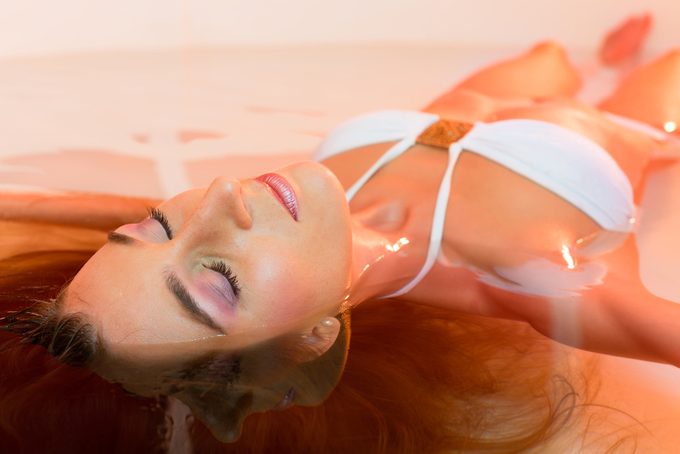Why You Should De-Stress in a Sensory Deprivation Tank
Curious about taking the plunge?

If you’ve heard of sensory deprivation tanks (also known as float tanks) but have been hesitant to take the plunge, you’re not alone. And if you suffer from claustrophobia the idea might be especially unnerving to you. The good news is you’re always in control of your environment and even people with extreme claustrophobia can enjoy the tanks. In fact, sensory deprivation tanks offer so many health benefits, they’re like a hidden oasis where we can reach a meditative state of wellness within our bustling cities.
The benefits of sensory deprivation tanks
Curious to try a sensory deprivation tank? We asked Jesse Ratner-Decle, co-founder of FLOAT Toronto to walk us through the benefits.
Physical: “You’re getting a deep muscle relaxation,” says Ratner-Decle. Since you’re completely buoyant in the tank, your muscles, bones and joints are all in a state of complete relaxation. “This is great for athletes or active people as it speeds up the healing process and muscle recovery.” The high content of magnesium in the water also provides several benefits. According to Ratner-Decle, “An increase in magnesium absorption helps prevent heart disease, reduces stress and helps build stronger teeth and bones.” It’s also great for your skin and may provide relief for those with eczema and psoriasis.
Mental: Sensory deprivation tanks are a great stress reliever because of the lack of stimulus. “The relaxation response your body has in the tank causes your body to release endorphins, decreasing feelings of depression,” says Ratner-Decle.
Spiritual: These benefits are subjective to each person, says Ratner-Decle. “People are left to their own thoughts in the pitch black of the tank. It’s meditative and introspective.”
What to expect at your first visit
Most float centres have a vibe similar to a yoga studio or a spa. As soon as you walk in the door, you feel a sudden sense of calm.
Book an appointment ahead of time to ensure there’s a sensory deprivation tank available at your preferred time. Most centres provide amenities like water, robes, towels and hair dryers but check first to make sure. Ratner-Decle suggests eating a light meal about 90 minutes before a visit so you’re fully settled when in the tank and not distracted by hunger or stomach rumblings.
At your first visit you’ll get a tour of the facilities. Some centres offer you the option to select a tea for after your treatment, or music or a meditation to listen to while floating.
After you tune your float to your liking, you’ll head to your float room, shower, and then hop in the tank, ready to unwind for an hour or more. Most centres allow you to float from anywhere between 1-2 hours. When your float is done, soft music will play or a soft light will go on, gently notifying you that it’s time to wake up and get out, without killing your vibe. You can shower, get dressed and head out, or you can head to a spot that some centres refer to as a “Zen room,” to have your tea, draw, read and relax before heading back out into the real world.
What happens when you enter the sensory deprivation tank?
You are in control. You can choose to close the tank, keep it completely open, or stick a towel in the door to prop it open slightly, but the best benefits come when you’re in the soundproof, lightproof tank, says Ratner-Decle. In the tank, you’re completely buoyant due to the amount of Epsom salt in the water. In FLOAT Toronto’s tanks, 10 inches of water have 1000 pounds of Epsom salt! The water is a neutral temperature around 34.5 degrees Celsius, which is the average skin temperature.
“Because there is no stimulus and tactile stimulation and your brain doesn’t have to process anything, you ease into this deep physical and mental relaxation,” says Ratner-Decle. You don’t have to support your body and your mind doesn’t have to deal with any distractions.
What’s it really like?
Vanessa Faria, a Licensed Soul Therapist, pilates instructor and dancer, hits up float tanks at least once monthly. She first heard about floating a few years ago when she was in school and her body was really exhausted from dancing eight hours a day.
“The first time I went I had a few hours before a technical rehearsal and I was really nervous and stressed so I decided to try and see if it would ease my physical pains and tensions as well as give me some mental reprieve. I felt energized and fresh ready to dance fully present and in tune with my body in a way I hadn’t previously experienced with a sense of ease and grace,” says Faria.
Since it helped her on so many levels, she decided to go back and make a routine out of it. “I now use the floatation tanks to meditate, relax, [and also] to visualize and connect to deeper parts of myself I can only access when the world is really dark and quiet,” says Faria.
Her biggest takeaway: getting grounded. “It’s necessary for humans who live in the city, where the world is constantly over-stimulating your all of your senses (mental, emotional, physical, spiritual) to slow down and take really private and personal space to let your whole self unwind and reset. It allows you to come back to ground zero and to feel, see, hear, and sense things from a more neutral space – one that feels like you’ve regained your sense of home. From all aspects of yourself.”




